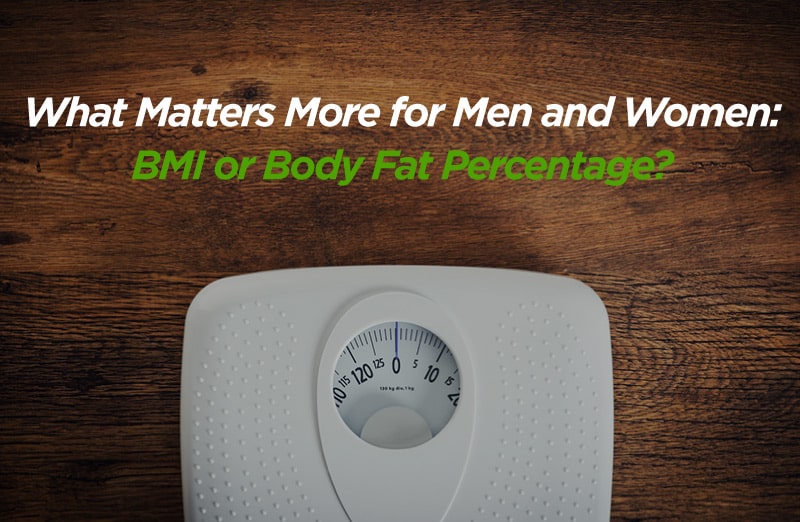What Matters More for Men and Women: BMI or Body Fat Percentage?

There are a million different ways to measure your health and fitness. You can track your cholesterol level or how long it takes you to run a mile or, of course, your bench press max. Body fat percentage and body mass index (BMI) are two hotly contested ways to determine how your weight and body composition may reflect your overall health. They both have their place in evaluating your health, but which is more important? Here’s what to know about BMI and body fat percentage calculations.
What Is Your BMI?

Your body mass index, or BMI, is a number calculated using your height and weight. This number will fall somewhere on a spectrum that is supposed to be an indication of your relative health. For instance, a person with a BMI that falls between 18.5 and 24.9 on the BMI chart is considered to be in the “normal” range for weight, according to the National Heart, Lung and Blood Institute. Anything below that is considered to fall within the “underweight” range. A number ranging from 25 to 29.9 is considered “overweight” and anything above 30 is regarded as “obese.”
According to the Centers for Disease Control and Prevention (CDC), while BMI does not measure your body fat directly, it’s been shown to have a moderate correlation to other, more direct measures of body fat, like skinfold thickness measurements and bioelectrical impedance. “Furthermore,” the CDC says, “BMI appears to be as strongly correlated with various metabolic and disease outcome(s) as are these more direct measures of body fatness.”
BMI is inexpensive and simple to work out, which gives it an advantage over more complicated, sometimes costly body fat percentage measurement methods. It can be a decent gauge for an average person’s relative health. Where it fails is specificity, however. Because it doesn’t directly account for body composition, there are outliers whose BMI could be misinterpreted. Case in point: Arnold Schwarzenegger. Judging by his BMI, the man is obese, even in his heyday. But, of course, there was hardly an ounce of fat on him.
How To Calculate Your BMI
The simplest way to calculate your body mass index is by using one of the many calculators you can find online, like this one from the National Heart, Lung and Blood Institute. Plug in your height and weight (there are options for metric measurements as well), and it spits out your BMI. From there, you can use a guide or chart to determine in which range your BMI falls.
Remember, though, that the BMI is just a guide and not a completely accurate measurement of your body composition. If you’re truly concerned about exactly how much fat you’re carrying around and its potential implications for your health, you’re going to want to use a method that gives you an accurate read on your body fat.
What Is Your Body Fat Percentage?

You body fat percentage is exactly what it sounds like: the percentage of fat you have in your body. So why is it important that you know what percentage of your body is comprised of fat? This information is helpful for a lot of reasons. For one, it’s a much better representation of obesity than BMI is. One study from the Singapore Medical Journal says that body fat percentage “plays a more important role in distinguishing between healthy and obese individuals, as it has a greater ability to differentiate between lean mass and fat mass compared to BMI.”
What does a healthy body fat percentage look like? BodyBuilding.com lays it out nicely. For women, it’s essential to have a minimum of 10 to 12 percent body fat. Men can get away with as little as 2 to 4 percent. For general fitness, it’s good to have between 21 and 24 percent for women and 14 to 17 percent for men. Anything above 31 percent for women and 26 percent for men is considered to be obese. Obesity is associated with a variety of impairments.
Understanding and adjusting your body fat percentage can help you reach your aesthetic goals as well. The lower your body fat percentage, the more your muscles will be able to show through. According to Livestrong, an acceptable body fat percentage range for a male bodybuilding competitor is between 3 and 8 percent. For female bodybuilding competitors, this number should hover around 10 percent. Going any lower than this, particularly for a long period of time, can have serious health complications, like liver and kidney problems.
How To Calculate Your Body Fat Percentage

There are a bunch of different ways you can determine your body fat percentage. These are only approximations, since there’s no way to know for certain what’s fat and what’s not, but some methods are far more accurate than others. From scales that measure body fat percentage in the comfort of your own bathroom to elaborate underwater weighing and bioelectrical measurements, the options are seemingly endless. If you’re serious about your health and knowing how your body fat percentage can impact that (which we know you are), the Mayo Clinic suggests skipping the less accurate at-home methods and going straight for the big guns.
The Mayo Clinic recommends three accurate body fat percentage measurement tools. The first is dual energy x-ray absorptiometry. It sounds like a mouthful, but it’s actually pretty simple. The specialized x-ray can detect detailed information about your fat, muscle and bones. Air displacement plethysmography, another mouthful of a name, is more commonly known as a Bod Pod. It’s an egg-shaped, computerized chamber that, through weight and volume, determines your body density and thus your body fat percentages. Hydrodensitometry is a form of underwater weighing that involves sitting on a special, submerged chair to determine your underwater weight or body density. From there, that information is used to determine your body fat percentage.
Most at home methods, like scales, can fluctuate wildly depending on your hydration level, according to Shape. If you’re going to go this route, take this inaccuracy into consideration and try to match conditions, like hydration and time of day, to get the most accurate read.
Understanding the differences between body mass index and body fat percentage, their pros and their cons can help you determine which method is better for you to gauge your health and fitness. Body fat percentage is going to give you a much more accurate representation of your body composition, but its measurement methods can be inaccessible. BMI doesn’t provide the detailed, specific information that body fat percentage does.
Want some serious inspiration for lowering your body fat percentage, improving your health and stepping up your fitness game? Find Performance Inspired on Facebook, Twitter and Instagram.



